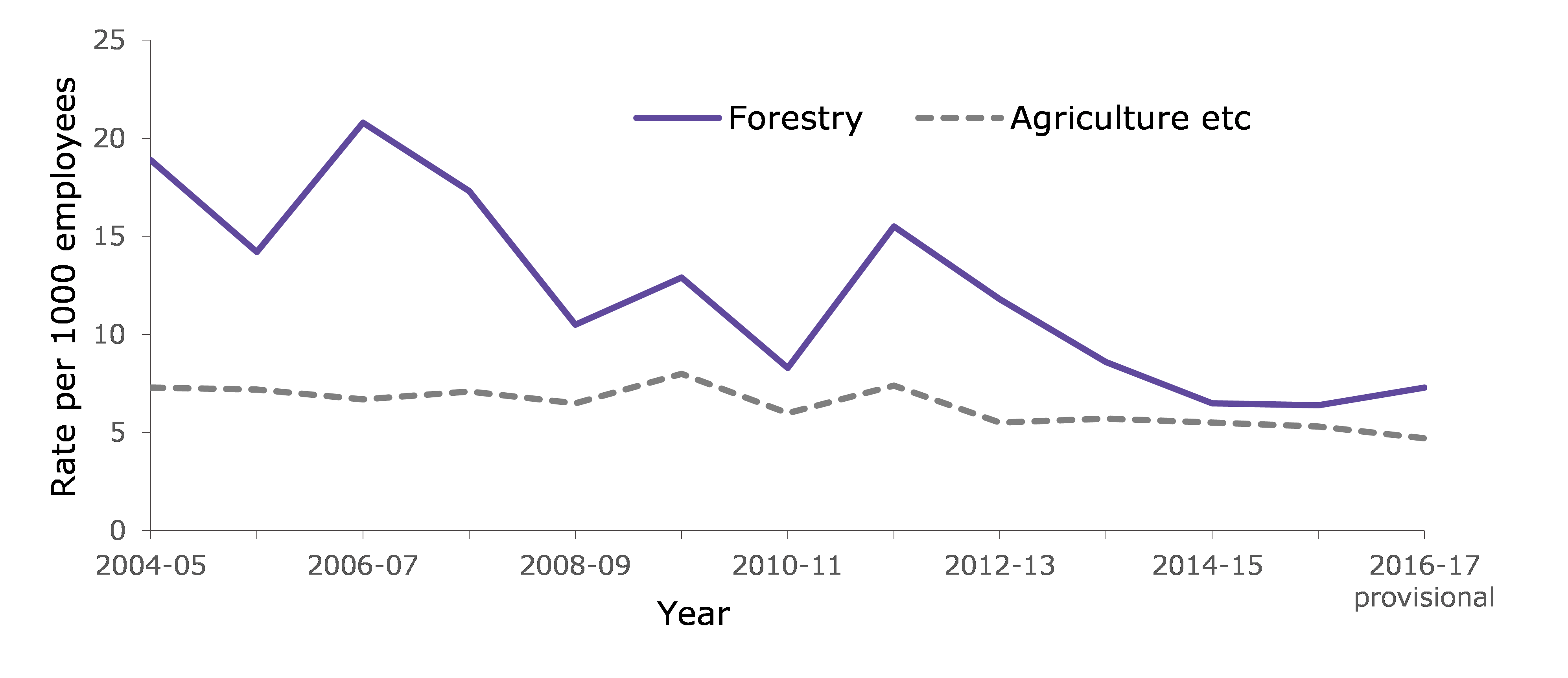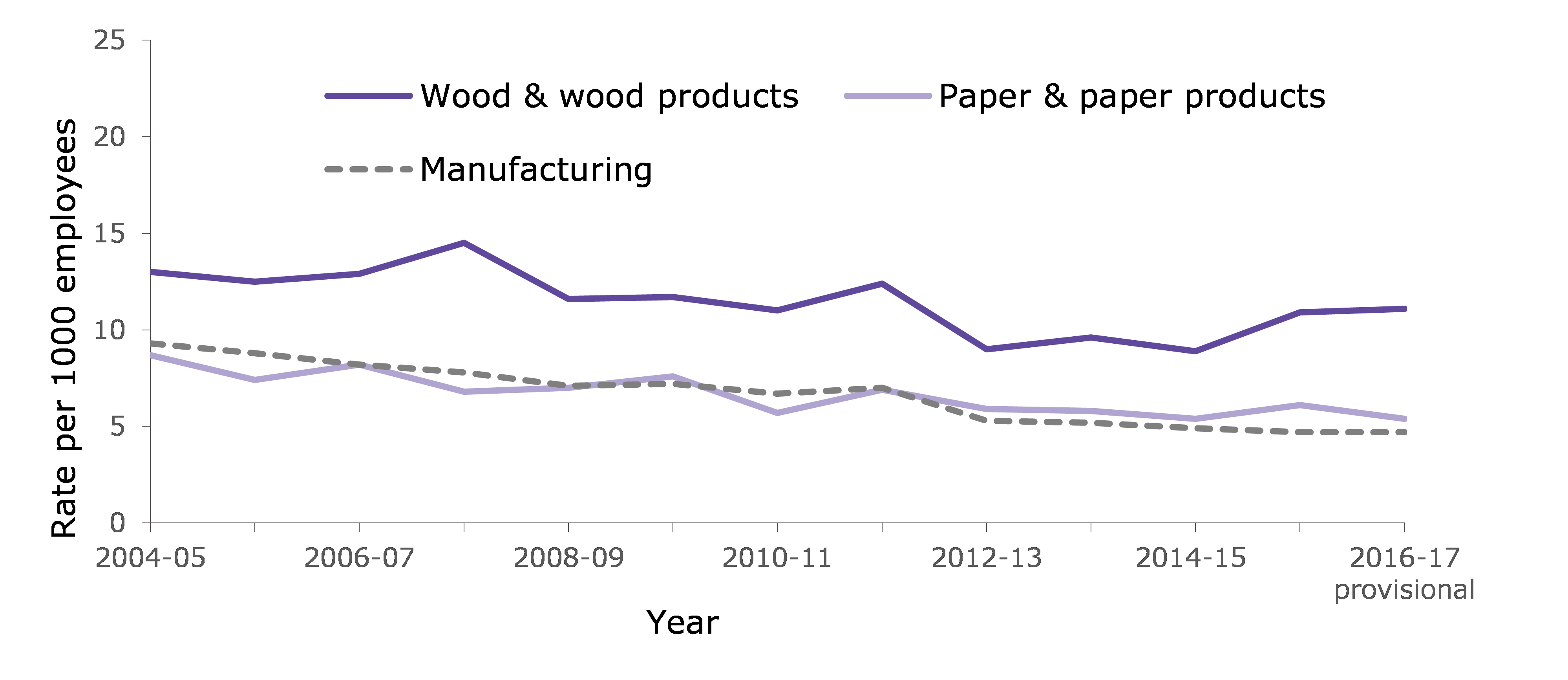Tools and Resources
We use some essential cookies to make this website work.
We’d like to set additional cookies to understand how you use forestresearch.gov.uk, remember your settings and improve our services.
We also use cookies set by other sites to help us deliver content from their services.
From April 2012, accidents involving absence from work of at least seven days are required to be reported to the Health & Safety Executive (HSE). Prior to this time, reporting was required for absences of at least three days.
The latest accident rates, for 2016-17, show an increase from the previous year for the forestry and wood products sectors. Over the longer term, the rates for both sectors have generally declined, but they remain higher than the averages in agriculture and manufacturing respectively (Table 7.3 and Figure 7.1).
Table 7.3 Accidents to employees1 in forestry and wood processing3, 2012-13 – 2016-17
| Standard Industrial Classification (SIC)2 | Major Accidents4 | Total Reported | ||
| Number | Rate/1000 employees | Number | Rate/1000 employees | |
| Forestry | ||||
| 2012-13 | 54 | 5.1 | 125 | 11.8 |
| 2013-14 | 51 | 3.8 | 116 | 8.6 |
| 2014-15 | 26 | 1.7 | 101 | 6.5 |
| 2015-16 | 34 | 2.0 | 111 | 6.5 |
| 2016-17 provisional | 31 | 1.9 | 120 | 7.3 |
| Wood products | ||||
| 2012-13 | 141 | 2.6 | 491 | 9.0 |
| 2013-14 | 155 | 2.8 | 523 | 9.6 |
| 2014-15 | 136 | 2.4 | 510 | 8.9 |
| 2015-16 | 129 | 2.5 | 561 | 10.9 |
| 2016-17 provisional | 150 | 3.0 | 557 | 11.1 |
| Pulp, paper & paper products | ||||
| 2012-13 | 76 | 1.4 | 323 | 5.9 |
| 2013-14 | 85 | 1.5 | 322 | 5.8 |
| 2014-15 | 75 | 1.3 | 303 | 5.4 |
| 2015-16 | 67 | 1.4 | 284 | 6.1 |
| 2016-17 provisional | 70 | 1.5 | 255 | 5.4 |
Source: Health & Safety Executive.
Notes:
1. Employees only; excludes self-employed.
2. Categories are based on the UK Standard Industrial Classification (SIC 2007) categories. Further details on the SIC codes used are provided in the Sources: Employment and businesses page.
3. Excludes other wood-using industries.
4. Major accidents include fatal accidents, which averaged around 1 per year for forestry and 2 per year for wood processing. There were no fatal accidents in the period shown for pulp, paper and paper products.
Figure 7.1 Accidents to employees : Total reported accidents per 1000 employees


Source: Health & Safety Executive.
Notes:
1. Employees only; excludes self-employed.
2. Categories are based on the UK Standard Industrial Classification (SIC 2007) categories. Further details on the SIC codes used are provided in the Sources: Employment and businesses page.
3. As a result of a change in reporting requirements, data from 2012-13 is not directly comparable with previous years.
Sources chapter: Employment and businesses
Cookies are files saved on your phone, tablet or computer when you visit a website.
We use cookies to store information about how you use the dwi.gov.uk website, such as the pages you visit.
Find out more about cookies on forestresearch.gov.uk
We use 3 types of cookie. You can choose which cookies you're happy for us to use.
These essential cookies do things like remember your progress through a form. They always need to be on.
We use Google Analytics to measure how you use the website so we can improve it based on user needs. Google Analytics sets cookies that store anonymised information about: how you got to the site the pages you visit on forestresearch.gov.uk and how long you spend on each page what you click on while you're visiting the site
Some forestresearch.gov.uk pages may contain content from other sites, like YouTube or Flickr, which may set their own cookies. These sites are sometimes called ‘third party’ services. This tells us how many people are seeing the content and whether it’s useful.